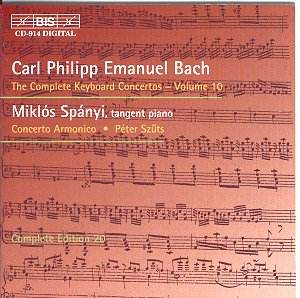Carl Philipp Emanuel BACH (1714-1788)
The Complete Keyboard Concertos - Volume 10 [69.05]
Concerto in G major H. 419 [24.28]
Sonatina in F major H. 452 [22.12]
Concerto in B flat major H. 447 [21.57]
 Miklós Spányi,
tangent piano
Miklós Spányi,
tangent piano
Concerto Armonico, Péter Szüts
Rec: October 1997
 BIS CD-914
[69.05]
BIS CD-914
[69.05]
Crotchet AmazonUK
AmazonUS
Amazon
recommendations

Carl Philipp Emanuel Bach was the most illustrious of Johann Sebastian Bach's
sons. His composing career was long and he was quite prolific, writing dozens
of sonatas, concertos and other works. (According to Miklós Spányi,
there are 52 keyboard concertos and 12 sonatinas, in addition to the many
solo keyboard works.) This recording contains two concertos and a sonatina
of vastly different character, composed over a period of 15 years.
One of the unique characteristics of this recording is the use of a tangent
piano - a sort of hybrid instrument whose sound lies somewhere between the
harpsichord and clavichord. It has a beautiful sound, and is quite unique.
The down side is that, like the clavichord, it is a very soft instrument,
and it does not work well with an instrumental group.
The G major concerto is dated 1745 but may have been written earlier. The
fast movements have an elegant, gallant feel to them, with the solo keyboard
sections being quite virtuosic. The slow central movement is very expressive,
and slides back and forth between the major key and a minor mode. This is
an attractive piece, with some beautiful passages in the third movement,
as the keyboard develops an interesting interplay with the orchestra.
Rather than the usual fast-slow-fast concerto form, the F major sonatina
follows a slow-fast-slow form. This work, originally written for public concerts,
is scored for keyboard, strings and winds, and the opening largo is more
focused on the orchestra than the keyboard. The long third movement (over
11 minutes long on this recording), however, is where the keyboard shines.
The alternating solo and tutti sections are dominated by the keyboard. Unlike
the usual alternations heard in concertos, this movement is almost like a
small suite. The orchestra plays a short section (itself containing a striking
conflict between slow sections with strings and winds and faster sections
with the entire orchestra and keyboard), then the keyboard plays its part,
and this continues several times. These solo keyboard sections, which are
like little solo pieces, are certainly the high point of this recording.
It is here that one can fully appreciate the sound of the tangent piano,
a relatively rare instrument on recordings. Unfortunately, it is also here
that one finds the most contrasts in volume between the keyboard and orchestral
passages. This makes for difficult listening, as one needs to turn the volume
up to heard the tangent piano, but the resulting volume of the orchestra
is overwhelming.
The B flat major concerto is a much more 'balanced' work - this is closer
to the 'standard' concerto form than the F major sonatina. With its three
movements all around the same length, and its highly developed keyboard parts,
this work is more sophisticated musically than the other two pieces on this
disc. The melodies developed in the first movement are very attractive, and
shows Bach here at his most creative.
Overall, this is a satisfying recording. The three works on this disc are
very different, and show a fine overview of CPE Bach's style. It is refreshing
to hear an instrument that is not recorded often, although the recording
itself is a fine example of why this is the case - the tangent piano is too
soft in comparison with the orchestra, leading either to headaches, from
turning the volume up enough to hear it, or to constant changing of the volume.
I find it difficult to imagine that this instrument was used in performance
with an orchestra, albeit small. Perhaps it was located close enough to a
small audience for them to hear it better.
An attractive recording of three very different works for keyboard and orchestra,
featuring a tangent piano. While the relative volume of the keyboard is a
problem, the music is delightful and well-performed.
Kirk McElhearn

